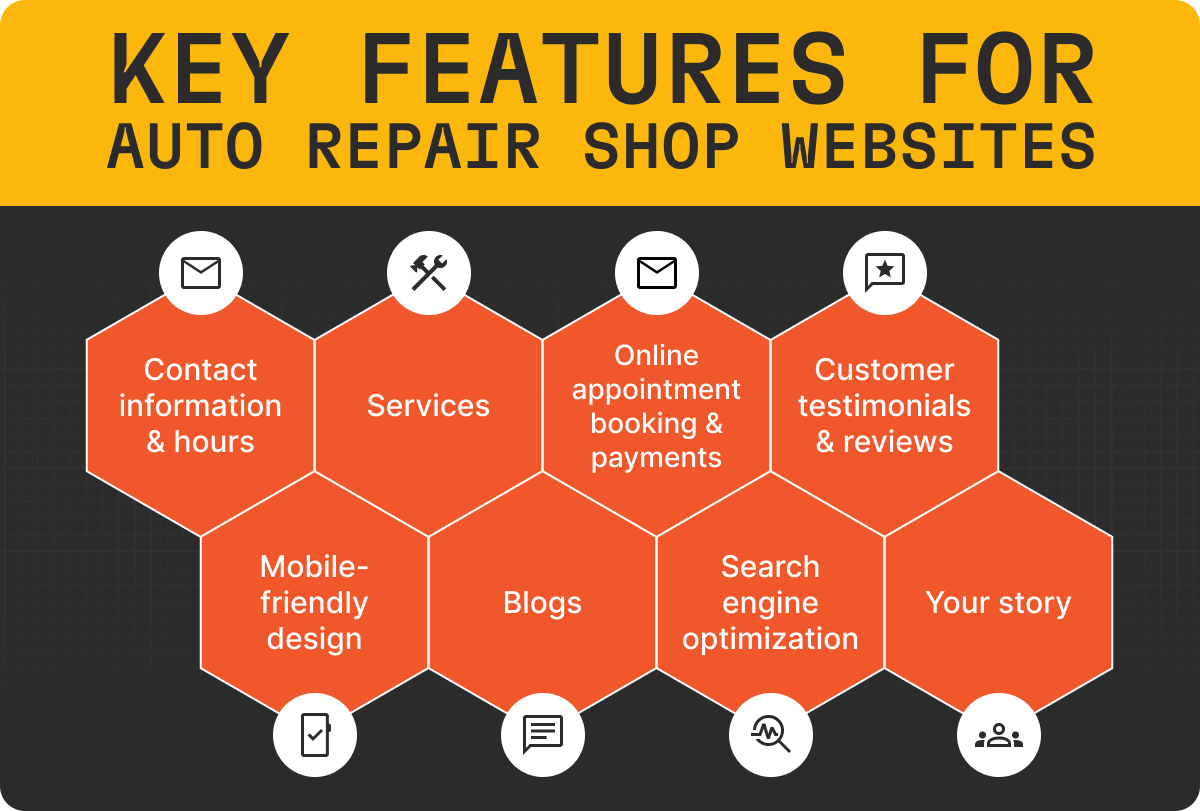Should auto repair shops focus on social media marketing?
How many people do you know who spend a substantial amount of time on Facebook? Or hours watching YouTube? How can your business take advantage of how easy it is to get in front of potential customers?
Social media became the leading online activity in 2013 and has grown ever since. According to a Backlinko study, there are 5.24 billion global social media users that average over 2 hours a day on social media platforms. The top three social media platforms are Facebook, YouTube, and WhatsApp.
Chances are that your potential new customers are spending more time online than anywhere else. Is your auto repair shop doing everything it can to reach them?

Source: https://backlinko.com/social-media-users
Social media channels are key for boosting your shop's reputation and make a big difference when it comes to driving referrals and repeat customers. Engaging your local community will keep you top-of-mind as a reliable, trustworthy place for your guests to get their vehicles repaired.
10 effective social media strategies for auto repair shops
Social media channels are one of the most powerful forms of word-of-mouth advertising; more and more people go on social media to make purchasing decisions as well as socialize with friends and family members.
By having a strong social media presence, it makes it easier for the people you serve to share information about your shop, whether that be promotions, insightful posts, or even fun photos that your auto shop shares. But there are so many ways to engage the people in your service area on social media that it can be tough to know where to start.
To make things easier, here are ten ways that your auto repair shop can use Facebook, Instagram, YouTube, LinkedIn, TikTok, Twitter and other channels to interact and socialize with potential customers and loyal guests.
1. Think local
It’s important to remember that social media channels—especially Facebook—are places where people often go to talk about a shared experience. A lot of times, those experiences are local. Whether it’s how the sports teams in town are doing, where people like to go, or upcoming events, the bulk of many online social media conversations is still driven by what’s happening in our own communities.
Businesses are a big part of that conversation. How often have you seen friends or family members post a question on their feed like “Know any good restaurants in town?” People also post public reviews and recommendations of the places they go and the businesses they use on Facebook, Google, Yelp, and other channels.
While it may not be direct marketing, starting a dialogue about what’s going on in your community may be a good way to start some conversations. Are there any new happenings? Are there charitable or uplifting things that people are doing in your community? You can even talk about the local driving experience, highlighting best roads to take during certain times of the week and any ongoing construction projects that drivers may want to be careful when diving past for the sake of their vehicle.
These are just a few of the things that you can address on your Facebook page to get guests talking and make your shop more approachable.
2. Local charities and events
Looking for ways to play a bigger role in your community? Consider using your social media pages to focus on other businesses, events, and charitable activities in your town. While this may seem to take the focus off of your shop and services, it shows your neighbors and guests that you care about the well-being of your community at large.

For example, Casey’s Automotive in Chantilly, Virginia promotes and partners with the local charity, Ellie’s Hats, an organization that raises funds to support children who have been diagnosed with cancer. Every year, Casey’s and Ellie’s Hats hold an annual Spring Fling car show where the kids get to help hand out prizes for different cars and people get custom-built trophies made out of car parts. By partnering up, Casey’s is not only helping make the world better by living out their values but also engaging the community and gaining potential future referrals.
3. Teach your followers something cool or valuable
Showing guests how to do something is a great way to give them something of value, establish leadership, and build trust. A good auto shop owner can always appreciate guests who take care of their vehicles between visits, so showing guests how to take care of their car may be worth sharing and demonstrate that you truly care about your guests’ vehicles.
In addition, some guests may find things that are simple for technicians and other experienced vehicle owners, such as performing an oil change or rotating tires, to be difficult or more of a hassle than they want to take on, and will instead bring the job to you.
4. Show gratitude and understanding
Guests are the backbone of any auto repair shop. Without them, you wouldn’t be in business. Show your guests that you value them! Sometimes this is better done in person, but if a guest is particularly loyal, or you provided them with some interesting, exciting repair work, you may want to ask them if you can feature them on social media and thank them for coming in.
If someone leaves a 5 star review on Facebook, Google, Yelp or somewhere else, or says something positive about your business, be sure to thank them for taking the time to do so. If the review was not made on a public site, and you got it from a customer by email or text, you should ask them permission to share their review before posting it on social media.
If the review was not made on a public site, and you got it from a customer by email or text, you should ask them permission to share their review before posting it on social media.
Either way, it’s like a trophy; show it off!

5. Respond appropriately to poor reviews
The best way to handle negative reviews (and chargebacks, for that matter) is to prevent them from happening in the first place by providing excellent customer service and communicating clearly with your customers. That said, there is always the chance that something will slip through the cracks or that someone will post something because they’re having a bad day. Not all negative reviews are within your control.
Most channels allow you to respond to guests. Talk to your service advisors and technicians to find the specific circumstances of the complaint being made so you have all the facts before responding.
Then, respond in a timely manner; you don’t want to let a review linger for days before responding.
When you do respond, stay courteous and professional, no matter how rude or out-of-line the customer’s review is. If you are able to encourage them to take the conversation offline by calling you, do so. Sometimes, a little attention will encourage the customer to remove their negative review.
If not, at least the public can see that you paid attention and took every possible step to meet their needs. If the review is entirely fabricated, you may be able to challenge it through an official appeal process on the site; Yelp, for example, allows you to flag a review for removal.
It’s also helpful to be proactive about gathering positive reviews so they drown out the negative ones and lessen their impact on both your potential customers’ shopping experience and your overall average business rating on the review site.
6. Highlight seasonal holidays & events
The holidays are a natural part of the yearly newscycle. They’re also fun for a lot of people, and a time when families and friends come together to celebrate something important. By highlighting holidays and using proper hashtags, your shop can gain more attention, inspire action, and be a part of the community's seasonal activities.
Don't forget to use the proper hashtags for seasons and events in your posts. These can help gain attention, but only if you use hashtags that show up in news feeds!
Some holidays move around on the calendar, but here are some dates and hashtags to use for certain holidays and events that take place over the course of the year:
January
- 1st, #NewYearsDay
- 16th, #GetToKnowYourCustomersDay
- 20th, #MLKDay
- 25th, #ChineseNewYear (1/25 - 2/8)
February
- 4th, #WorldCancerDay
- 14th, #ValentinesDay
- 17th, #KindnessDay (Random Acts of Kindness Day)
- 22nd, #NationalMargaritaDay (Don’t drink and drive!)
- 25th, #MardiGras (Same as above)
- 27th, #NationalRetroDay
March
- 6th, #EmployeeAppreciationDay
- 8th, #InternationalWomensDay
- 17th, #StPatricksDay
- 23rd, #NationalPuppyDay
- 25th, #WaffleDay
- 28th, #EarthHour
- 30th, #NationalDoctorsDay
April
- 1st, #AprilFools
- 15th, #TaxDay
- 16th, #HighFiveDay
- 22nd, #EarthDay
May
- 4th, #MayThe4thBeWithYou (National Star Wars day)
- 5th, #ThankATeacher (National Teacher’s Day)
- 10th, #MothersDay
- 12th, #NursesDay
- 15th, #ChocolateChipDay
- 21st, #AccessibilityAwarenessDay
- 25th, #MemorialDay
June
- 5th, #DonutDay
- 6th, #HigherEducationDay
- 8th, #BestFriendsDay
- 12th, #NationalAutomotiveServiceProfessionalsDay
- 14th, #FlagDay
- 15th, #NativeAmericanCitizenship
- 21st, #FathersDay
- 30th, #SMDay (Social Media Day)
July
- 1st, #TellAJoke (International Joke Day)
- 4th, #IndependenceDay
- 7th, #WorldChocolateDay
- 14th, #BastilleDay
- 17th, #WorldEmojiDay
- 19th, #NationalIceCreamDay
- 26th, #ParentsDay
- 30th, #InternationalDayOfFriendship
August
- 15th, #NationalRelaxationDay
- 19th, #WorldPhotoDay
- 26th, #NationalDogDay
September
- 5th, #InternationalDayOfCharity
- 6th, #ReadABookDay
- 7th, #LaborDay
- 21st, #DayOfPeace
- 29th, #NationalCoffeeDay
- 30th, #InternationalPodcastDay
October
- 4th, #NationalTacoDay
- 16th, #NationalBossDay
- 31st, #Halloween
November
- 3rd, #ElectionDay (2020)
- 11th, #VeteransDay
- 13th, #WKD (World Kindness Day)
- 26th, #Thanksgiving (2020)
- 27th, #BlackFriday (2020)
- 28th, #ShopSmall (Small Business Saturday, 2020)
- 30th, #CyberMonday (2020)
December
- 1st, #GivingTuesday (2020)
- 3rd, #IDPD (International Day of Persons with Disabilities)
- 9th, #ChildrensDay
- 10th, #HumanRightsDay
- 25th, #Christmas
- 31st, #NewYearsEve
7. Social media contests
Everyone loves a raffle, and everyone loves a gift card. Gift card lotteries are a simple way to encourage people to like your posts, share your posts, and provide you with a good review.
We often see auto shops use monthly gift card drawings as a way to continually drum up engagement. It’s also a good way to work in some general education for your customers.
For example, you can make the gift card amount match the exact amount of an oil change to remind customers that they need to get that done to take the best possible care of their vehicle.
Photo contests are another way to get more exposure and traffic to your social media page. You can pick a topic and encourage guests to post or submit their photos on social media and tag your auto shop. Create an award, like a service certificate or gift card, and pick a winner!
8. Like, share, and comment
It’s not enough to just post content and hope people engage with it. Remember to like, share, and comment on your own posts and on other people’s, too, when it’s appropriate.
Sometimes reminding page visitors to like, share, and comment on your own posts is all that’s needed to encourage them to engage.
Here are some example posts that you can try on your own feed:
- "Like us and share your experience on social media and get $5 off!"
- "First 5 people to share and comment get 15% off their next visit."
- “We’re proud to support first responders. Share this post if you are, too.”
- “We’re always trying to improve our guest experience. What can we do to improve our service to you and our community? Tell us in the comments.”
9. Diversify your channels
Between Google My Business, Facebook, YouTube, Instagram, TikTok, and even your shop’s website, there are a lot of places where potential guests may go for information. Posting on all platforms may seem complicated at first, but you can always reshare content. For example, if you post a blog or new service page on your site, be sure to share it on Facebook and Twitter. Did someone leave a good Google review? Post about it on Facebook and thank them! Just upload a YouTube video? Share it on Facebook!
Some social media sites, like Facebook, have built-in scheduling tools that could make it easier to schedule posts without using an outside platform.
Also remember it’s okay to start small; you don’t have to use every single social media channel. If you find a channel does not drive leads by engaging customers or driving search traffic to your website or social media pages, don’t use it.
You are not obligated to use every social media network and may find that it’s only worth using one or two for your business.
10. Have fun!
Probably the most important tip of them all: have fun. Remember, social media is typically a place where people go to engage with socially engaging content. Content that is too serious may make your feed look stale, and make it difficult for potential customers to relate to your brand.

If you can capture your technicians, service advisors, and even yourself having a good time, it breaks the ice and may entice people to do more business at your shop. We’ve seen shops post pictures of team building events as well as pictures that show off their goofy side; the team at Casey’s Automotive has done a good job of posting lighthearted content and photos of their team having a good time, and it has helped them gain more than 2,000 followers.
On May 4th, you can have your team pose for a lightsaber battle. October 16th is National High Five day, so be sure to post some good high-five pictures and emojis on your Facebook page. 🙏 👏

Social media post ideas for auto repair shops
Customer-Centric Content
- “Car of the Week” Feature – Showcase an interesting repair job or classic vehicle that came through the shop.
- Customer Spotlight – Share a short story or testimonial from a happy customer (with permission).
- Before & After Visuals – Post transformation photos of a repair or detailing job.
- Behind-the-Scenes Tours – Give a video or photo tour of your shop and introduce your team.
Educational & Helpful Tips
- Seasonal Maintenance Reminders – Inform customers about what their vehicle needs in winter, summer, etc.
- “Tech Tip Tuesday” – A weekly snippet of car care advice from your technicians.
- Warning Signs 101 – Teach customers how to spot common issues (noises, leaks, dashboard lights).
- Myth-Busting Posts – Tackle popular car care misconceptions.
- Checklist Downloads – Share helpful PDFs or graphics (e.g. "Maintenance reminder checklist").
Interactive & Engaging Posts
- “Guess the Problem” Game – Post a photo or video clip and have followers guess the issue.
- Vote for your favorite car - Create a poll asking followers to pick their favorite car.
- Customer Q&A Sessions – Invite followers to drop questions in comments for your techs to answer.
- Throwback Posts – Share old shop photos or stories from the early days.
Trust & Transparency Builders
- Meet the Team Posts – Personal bios, favorite tools, or “a day in the life” of a tech.
- Explainer Videos – Short clips that walk through common repairs or shop processes.
- Tool Spotlight – Show off unique or advanced tools you use and why they matter.
- Customer Review Highlights – Turn your Google or Yelp reviews into branded quote graphics.
Fun, Culture & Promotions
- Shop Culture Moments – Celebrations, birthdays, pets in the shop, or Friday playlists.
- Contests & Giveaways – Oil change giveaways, “Tag a friend who needs a tune-up” style promos.
- Local Business Shoutouts – Cross-promote other small businesses in your area.
- Milestone Celebrations – Anniversaries, number of vehicles serviced, or team achievements.
Final thoughts
Remember, engaging guests on social media is just one way to improve your auto repair shop. There are other important marketing strategies to utilize such as search engine optimization, Google Ads, email marketing, and more. Lastly, always focus on creating an amazing customer experience to encourage customers to share their experience with others.


.png)

.png)
.png)



.svg)



.svg)